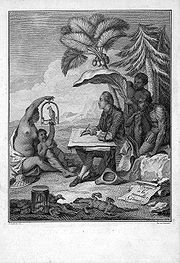
Pierre Sonnerat
Encyclopedia

France
The French Republic , The French Republic , The French Republic , (commonly known as France , is a unitary semi-presidential republic in Western Europe with several overseas territories and islands located on other continents and in the Indian, Pacific, and Atlantic oceans. Metropolitan France...
naturalist
Natural history
Natural history is the scientific research of plants or animals, leaning more towards observational rather than experimental methods of study, and encompasses more research published in magazines than in academic journals. Grouped among the natural sciences, natural history is the systematic study...
and explorer.
Sonnerat was the nephew of the botanist Pierre Poivre
Pierre Poivre
Pierre Poivre was a French horticulturalist born in Lyon; missionary to China and Cochinchina, Intendant of the Islands of Mauritius and Bourbon, and wearer of the cordon of St. Michel...
. He made several voyages to southeast Asia
Asia
Asia is the world's largest and most populous continent, located primarily in the eastern and northern hemispheres. It covers 8.7% of the Earth's total surface area and with approximately 3.879 billion people, it hosts 60% of the world's current human population...
, visiting the Philippines
Philippines
The Philippines , officially known as the Republic of the Philippines , is a country in Southeast Asia in the western Pacific Ocean. To its north across the Luzon Strait lies Taiwan. West across the South China Sea sits Vietnam...
and Moluccas between 1769 and 1772, and India
India
India , officially the Republic of India , is a country in South Asia. It is the seventh-largest country by geographical area, the second-most populous country with over 1.2 billion people, and the most populous democracy in the world...
and China
China
Chinese civilization may refer to:* China for more general discussion of the country.* Chinese culture* Greater China, the transnational community of ethnic Chinese.* History of China* Sinosphere, the area historically affected by Chinese culture...
from 1774 to 1781. He was the first person to give a scientific description of the south Chinese fruit tree lychee
Lychee
The lychee is the sole member of the genus Litchi in the soapberry family, Sapindaceae. It is a tropical and subtropical fruit tree native to Southern China and Southeast Asia, and now cultivated in many parts of the world...
. He is the person who misinterpreted the call of a helpful Malagasy
Madagascar
The Republic of Madagascar is an island country located in the Indian Ocean off the southeastern coast of Africa...
guide who had spotted a lemur
Lemur
Lemurs are a clade of strepsirrhine primates endemic to the island of Madagascar. They are named after the lemures of Roman mythology due to the ghostly vocalizations, reflective eyes, and the nocturnal habits of some species...
and shouted "indri!" ("look!" in Malagasy
Malagasy language
Malagasy is the national language of Madagascar, a member of the Austronesian family of languages. Most people in Madagascar speak it as a first language as do some people of Malagasy descent elsewhere.-History:...
). Sonnerat took this to be the animal's name, and it is still known as an Indri
Indri
The indri , also called the babakoto, is one of the largest living lemurs. It is a diurnal tree-dweller related to the sifakas and, like all lemuroids, it is native to Madagascar.- Etymology :...
(Indri indri) today (the actual Malagasy name is babakoto). The birds Dacelo novaeguineae and Pygoscelis papua, neither of which are found in New Guinea
New Guinea
New Guinea is the world's second largest island, after Greenland, covering a land area of 786,000 km2. Located in the southwest Pacific Ocean, it lies geographically to the east of the Malay Archipelago, with which it is sometimes included as part of a greater Indo-Australian Archipelago...
(Papua), were also misnamed due to Sonnerat.
His books included Voyage à la Nouvelle-Guinée (1776) and Voyage aux Indes orientales et à la Chine, fait depuis 1774 jusqu'à 1781 (1782).
The standard botanical author abbreviation Sonn. is applied to plants he described.
His name is used in the specific name of the Grey Junglefowl
Grey Junglefowl
The Grey Junglefowl , also known as Sonnerat's Junglefowl, is a wild relative of domestic fowl that is endemic to India. This species is found mainly in peninsular India and where it overlaps with the distribution of the Red Junglefowl, it is known to form hybrids...
(Gallus sonneratii).
Pierre Sonnerat spoke out against the prevalent racism in the European circles of his time. During his visits to Asia he marvelled at the rich culture of the Indians. In one of his books Sonnerat writes "Ancient India gave to the world its religions and philosophies: Egypt and Greece owe India their wisdom and it is known that Pythagoras went to India to study under Brahmins, who were the most enlightened of human beings."

